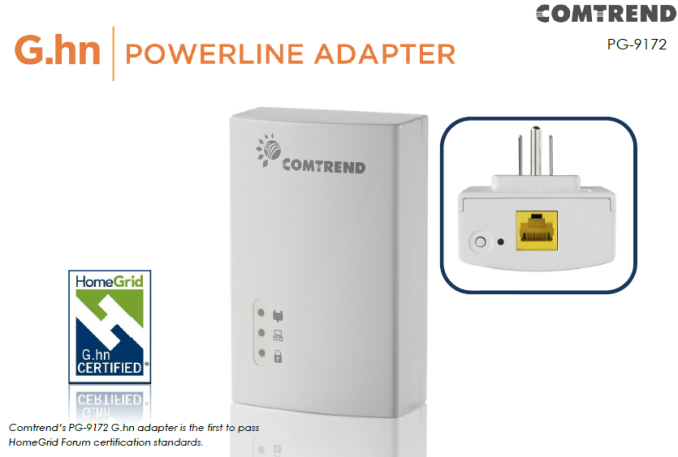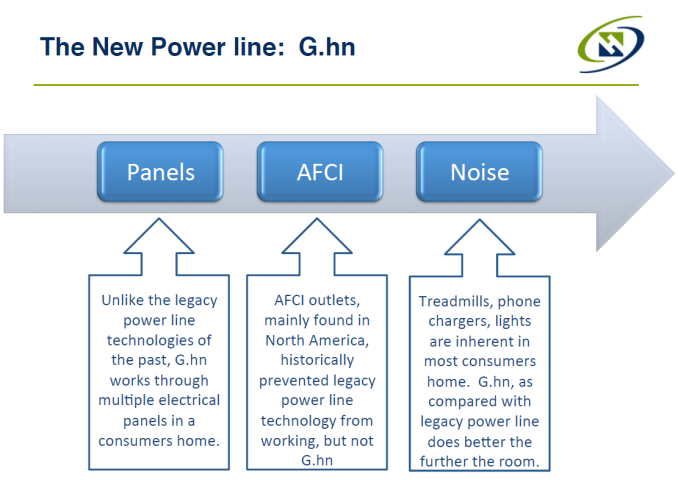Comtrend PG-9172 Powerline Adapter Review: G.hn Gets Primed for Retail Push
by Ganesh T S on May 3, 2016 8:30 AM EST- Posted in
- Powerline Adapters
- Networking
- Marvell
- G.hn
- HomePlug
- Comtrend
Concluding Remarks - What is Next for G.hn?
The Comtrend PG-9172 G.hn powerline adapter gave us the opportunity to look at G.hn technology in real-world scenarios. Our evaluation shows that the technology is quite competitive in terms of performance. It shows better resilience to noise and performs better than HomePlug AV2 products from late 2014 in almost all scenarios. In particular, AFCI circuit breakers don't seem to cause as much performance degradation in the PG-9172 as they cause in HomePlug adapters. All in all, the product delivers upon its claims and performs as expected. We hope to add some comparative numbers from the newer class of AV2000 HomePlug products in the near future.
Positives aside, Comtrend could definitely do with better default settings in the firmware (particularly for power efficiency). The firmware update process must be made more reliable. Better software QA wouldn't hurt. The HTTP interface should also be made more user-friendly with better capabilities.
It is great to finally see G.hn technology in retail. It might be painful in the short term due to initial coexistence issues, but, we can see that the G.hn side is taking a lot of effort to minimize the problems. HomePlug has a huge install base and still holds the lead, but, G.hn is no longer a vaporware competitor. That said, we would like to see more commitment to G.hn from Tier-1 vendors.
There is hardly any doubt that G.hn, considered standalone, provides a better user experience and has technical advantages. The issue has always been market acceptance and the existing install base of HomePlug demanding backwards compatibility in the pure powerline communication space.
The rising popularity of mobile devices has made Wi-Fi indispensable in the home network. However, wireless dead spots have been a major pain point for consumers. Most networking vendors have been trying to solve the wireless dead spot problem with a mixture of different products - Wi-Fi extenders, powerline adapters and other similar devices. Wi-Fi extenders usually don't deliver great user experience because the radio constantly switches between client and AP (access point) modes resulting in lowered effective bandwidth. A wired-to-Wi-Fi extender (using powerline technology) enables the extender to be in the AP mode 100% of the time, and in a different channel too. HomePlug built upon this strategy to become part of the Hy-Fi standard, aimed at making hybrid networking popular in the market. However, the Hy-Fi scheme has largely been given a cold shoulder by the market.
The HomeGrid forum and Marvell believe that the solution for a cost-effective and great user experience lies in the usage of G.hn as a backbone. The introduction of the ARRIS SURFboard RipCurrent series (a family of routers and extenders using G.hn technology) is indicative of G.hn's further push into retail channels. It is also an example of the hybrid networking idea as envisioned by the HomeGrid forum.
The announcement of the RipCurrent lineup also opens up the interoperability aspect of the Comtrend PG-9172. Given that both products are based off Marvell silicon, and both carry HomeGrid forum certifications, it shouldn't be an issue. Hopefully, our planned evaluation of the ARRIS SURFboard RipCurrent lineup will put any doubts to rest.
ARRIS is on board the G.hn train with their SURFboard RupCurrent lineup. It remains to be seen whether other Tier-1 vendors will join in. HomeGrid / G.hn seems to finally be on the right track and the momentum is now on their side. The HomePlug vs. HomeGrid tussle just got a lot more interesting.












48 Comments
View All Comments
kamm2 - Wednesday, May 4, 2016 - link
Yeah, 99.99% chance a home built in 1892 with good wiring does not have 1892 wiring. If it was even built with any wiring.extide - Wednesday, May 4, 2016 - link
While I agree with most of what you say, the words 'Occupancy' and 'Flipping' should never be used in the same sentence when talking about homes...kmmatney - Wednesday, May 4, 2016 - link
I would think it would just be easier to use wireless in an older home. With most people having laptops , phones, ipads, etc.. your going to be on wireless most of the time anyways. You can get repeaters easily enough. My home was built in 1999, with ethernet cables wired across the whole house, but it turns out a lot of the connections are not convenient, so I still use mostly wireless.I did use a powerline adapter for one connection, and found it was a bit finicky, and wouldn't work between all plugs (and I'm sure my wiring is fine).
mgrier - Tuesday, May 3, 2016 - link
Definitely. It would rock for a streaming box but I guess those tend to be small USB-powered and use wireless. I'd prefer to have a real outlet needed and avoid cluttering my wifi with video.Murloc - Thursday, May 5, 2016 - link
because the power network in houses is a mess or unknown to the owner and something always ends up not working.Wireless is just a better solution for most people and applications and even that isn't hassle-free.
fazalmajid - Tuesday, May 3, 2016 - link
I am getting spotty performance on a pair of PLA-5405 I use to bridge upper and lower floors in my 1936 house with electrical wiring upgraded in 2006 (odd layout makes Cat5/6unpractical, plaster and lath construction is highly effective at blocking WiFi). I ordered a pair of these and a pair of HomePlug AV2000 Extollo Lansocket 1500 that outperform them in other reviews. G.hn proponents claim it has better noise resistance, I'd like to put that to the test.Guspaz - Tuesday, May 3, 2016 - link
You seem to use the terms "HomeGrid" and "G.hn" interchangeably without ever explaining that they're the same thing. That was very confusing, as for most of the first page of the article, I thought you were talking about three different standards.Valantar - Tuesday, May 3, 2016 - link
I agree. It took me all of the first page to understand that G.hn and HomeGrid were the same thing. No clear link between the two names, and no mention in the introduction. What do the two names mean? Is one a standards organization, while the other is the name of their tech? If so, which is which? And why have two names at all?Guspaz - Tuesday, May 3, 2016 - link
I think adding a single word would solve the problem. Change this:However, despite silicon getting demonstrated at various trade shows, G.hn was unable to get a retail product out for a long time.
To this:
However, despite silicon getting demonstrated at various trade shows, HomeGrid's G.hn was unable to get a retail product out for a long time.
grazapin - Tuesday, May 3, 2016 - link
Yeah that first paragraph drops the names HomePlug, HomeGrid, G.hn and Comtrend with no explanation of how they relate to each other. I picked up most of it from context, but how G.hn fit in was not clear for most of the article. In fact, the only explanation that jumps out at me now is in the very last paragraph: "HomeGrid / G.hn"